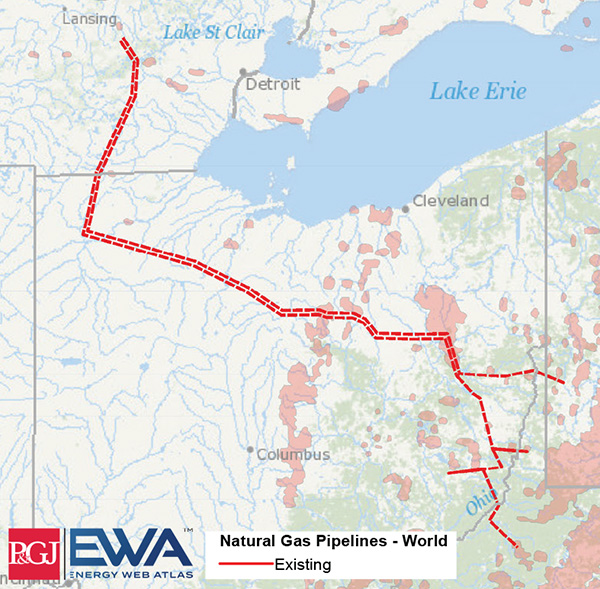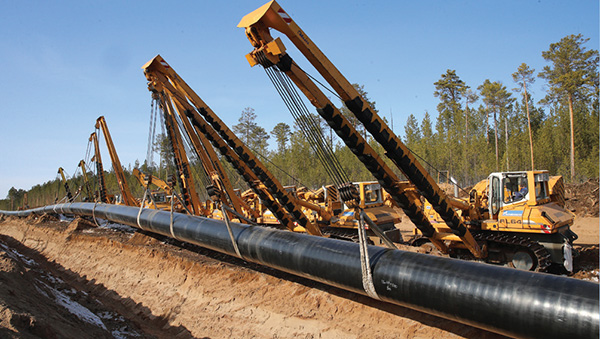January 2019, Vol. 246, No. 1
Projects
Projects
FERC Approves Final 2 Laterals on Rover Pipeline
Energy Transfer said service has begun on the final two laterals of Rover Pipeline following final approval from the Federal Energy Regulatory Commission (FERC).
Rover has been operational since August 2017, but FERC’s approval of the Sherwood Lateral, CGT Lateral and associated compression and metering facilities provides additional receipt and delivery points for natural gas production in West Virginia.
The 713-mile Rover Pipeline transports up to 3.25 Bcf/d of natural gas from the Marcellus and Utica Shale production areas.
Rover transports natural gas from processing plants in West Virginia, Eastern Ohio and Western Pennsylvania to the Midwest Hub, near Defiance, Ohio, for delivery to markets across the U.S., as well as to the Union Gas Dawn Storage Hub in Ontario, Canada.
Williams Given More Time to Get OK for Constitution Pipeline
U.S. energy regulators gave Williams Cos two more years, until December 2020, to get the approvals needed to build its long-delayed Constitution natural gas pipeline from Pennsylvania to New York, according to a federal.
If built, the 125-mile (201-km) pipeline would transport 650 MMcf/d of shale gas.
Before it can start building the project, Williams still needs water quality certification. New York state denied the permit in 2016, saying the company failed to provide enough information to determine whether the project would comply with state water standards.
Williams sued in federal court, arguing that New York waived its authority to decide on the certification by failing to act within a reasonable period. The case went all the way to the U.S. Supreme Court, which declined to review the appeals court judgment that upheld the state’s decision.
This is the second two-year extension for the pipeline, which has been bogged down in regulatory and legal battles since FERC approved construction in December 2014.
According to Reuters, Williams has said it would take about 10 to 12 months to build the pipeline after it receives the necessary approvals.
Bulgaria OKs Pipeline Linking Russian Gas to Central Europe
Bulgaria will spend $1.59 billion (1.4 billion euros) to build a new gas link to Turkey to transport Russian gas from the TurkStream pipeline to Europe, bypassing Ukraine to the south.
Bulgarian lawmakers gave the green light to the state gas company Bulgartransgaz to launch tenders to build the new 300-mile (484-km) gas link from its border with Turkey to Serbia by 2020 that will carry mainly Russian natural gas that will carry mainly Russian natural gas, according to Reuters.
TurkStream is part of the Kremlin’s plans to bypass Ukraine, currently the main transit route for Russian gas to Europe and strengthen its position in the European market.
Its two lines will each have an annual capacity of 15.75 Bcm. Russian energy giant Gazprom has completed the first line of pipeline to Turkey for local gas consumption.
Gazprom said it was considering booking capacity, which would effectively ensure that the gas Russia plans to send to Europe through its Black Sea pipeline will pass through its land.
Another Keystone XL Setback: Environmental Study Ordered
A federal court order blocked a Trump administration permit for the construction of the Keystone XL pipeline, pending an environmental review. However, the issuing judge later said some pre-construction work can resume.
The pipeline would begin in Alberta and shuttle as much as 830,000 bpd of crude through a half dozen states to terminals on the Gulf Coast.
U.S. District Judge Brian Morris initially put on hold the $8 billion project, ruling potential impact had not been considered.
In reaction, Andrew Black, president and CEO of the Association of Oil Pipe Lines (AOPL) said, “Every review of Keystone XL, including those by the Obama administration, has found pipelines are the safest and most environmentally protective way to move the energy we need, and I have no doubt further review will find the same.”
A U.S. State Department official told Reuters the agency will conduct the supplemental environmental impact statement for Keystone XL. The move could lead to additional delays of the project, but TransCanada has not provided an updated estimate of its completion date.
The company is evaluating joint ventures and asset sales, among other options, to finance its construction and has not made a final investment decision.
Firms Approve Pipeline to Supply Norwegian Gas to Poland
Polish and Danish gas grid operators Gaz-System and Energinet agreed to finance construction of the Baltic Pipe project, a 560-mile (900-km) pipeline that will reduce regional dependence on Russian supply by transporting Norwegian gas to Poland via Denmark.
Costs of the project, which will cross the territories of Denmark, Sweden and Poland, are projected to range between $1.8 billion and $2.4 billion (1.6 billion to 2.1 billion euros). Gas transmission is expected to start in late 2022.
In addition to transporting Norwegian gas through Denmark to Poland and other countries in the region, Baltic Pipe also will enable reverse transmission from Poland to Denmark and Sweden, its developers said.
At a news conference in Warsaw, Polish Energy Minister Krzysztof Tchorzewski described Baltic Pipe as part of the North-South Gas Corridor, a project to link Poland to an LNG terminal in Croatia, via the Czech Republic, Slovakia and Hungary, Reuters reported.
Expansion of the Polish transmission system constituting a further step to make Poland a regional gas hub, which will reduce the risk of supply disruptions and boost the national economy.
Norway meets about a quarter of Europe’s natural gas needs and is the second largest supplier after Russia. Most of its deliveries are via a network of offshore pipelines to Britain, Germany, France and Belgium.
Phillips 66, Bridger Plan Pipeline from Bakken to Texas
Phillips 66 and Bridger Pipeline announced they have preliminary plans for a new pipeline to send Bakken crude oil to Texas.
The Liberty Pipeline will transport 350,000 bpd of oil from the Bakken and Rockies production areas to Corpus Christi, Texas.
Bridger Pipeline spokesman Bill Salvin told the Bismarck Tribune there’s a need for more crude oil pipeline capacity from both North Dakota and Wyoming, adding interest from shippers will determine the final pipeline route.
The project will involve a combination of new construction and expanding existing pipelines. If the companies’ plans materialize and regulatory approval is given, the pipeline is expected to be operational by the fourth quarter of 2020.
Michigan Senate OK’s Bill to Enable Great Lakes Pipeline Deal
The Michigan Senate voted to enable a deal to replace a contentious 65-year-old oil pipeline in the Great Lakes, approving legislation to empower a new authority to oversee the construction and operation of a utility tunnel that would encase the new pipeline.
The bill, approved on a 25-13 mostly party-line vote in the Republican-controlled chamber, was sent to the House for consideration next. It would create the three-member Mackinac Straights Corridor Authority to handle functions related to building the tunnel, which supporters say would better protect against a potential spill.
Outgoing GOP Gov. Rick Snyder – who would appoint the initial members of the authority – is working on several fronts to finalize an October agreement with Canadian oil transport giant Enbridge to replace the underwater segment of its Line 5, which carries about 23 million gallons (87 million liters) of oil and natural gas liquids daily between Superior, Wisc., and Sarnia, Ontario.
A more than 4-mile-long (6.4-km) section, divided into two pipes, lies on the floor of the churning Straits of Mackinac, the convergence of Lakes Huron and Michigan.
The massive engineering project is expected to take seven to 10 years to complete, at a cost of $350 million to $500 million – all of which the company would pay. Opponents of the deal say oil and liquids used to make propane should not continue flowing daily through the lines.
Democratic Gov.-elect Gretchen Whitmer pledged during her campaign to shut down Line 5 and criticized the tunnel plan, as did fellow Democrat Dana Nessel, who won the race for attorney general. Both take office in January and have said the Snyder administration should not steamroll the plan to enactment in the meantime.
Republican Sen. Wayne Schmidt of Traverse City, whose district includes the pipeline, said the goal is to protect the Straits while making sure “energy is affordable, reliable and accessible. ... By doing a utility corridor, that is the absolutely safest way to do that.” Sen. Adam Hollier of Detroit, the lone Democrat to support the legislation, said it would ensure “people are taken care of in the winter” and also provide work for laborers who build the tunnel.
Opponents, however, continued to criticize the bill, which was changed to no longer have the existing Mackinac Bridge Authority help to enable the tunnel agreement.
Lone Star Express Pipeline to Expand, Add Fractionator
Energy Transfer’s Lone Star NGL subsidiary will expand the Lone Star Express Pipeline with a new 352-mile pipeline from West Texas and construct another Gulf Coast fractionation facility to meet growing demand, the company said.
The projects will connect constrained production from the Delaware and Permian Basins to Lone Star’s rapidly expanding Mont Belvieu complex, where its seventh fractionator will add 150,000 bpd of capacity.
The Lone Star Express Pipeline expansion will be a 24-inch pipeline that connects Lone Star’s pipeline system with its 30-inch pipeline south of Fort Worth. Energy Transfer said the expansion will provide capacity for “significant transportation commitments Lone Star has secured from the Delaware and Permian Basins.” It is expected to be in service by the fourth quarter of 2020.
Lone Star Express Pipeline is a 532-mile interstate system consisting of 24-inch and 30-inch long-haul, mixed NGLs transportation pipeline that can deliver up to 507,000 bpd of capacity from processing plants in the Permian Basin and Barnett Shale to Mont Belvieu NGL storage and fractionation facilities.
Lone Star’s announced Fractionator VII is scheduled to be operational in the first quarter of 2020. Energy Transfer said its 150,000 bpd of capacity has already been fully subscribed by multiple long-term contracts.
US Approves Part of TransCanada WB XPress for Service
U.S. federal energy regulators approved a request by TransCanada’s Columbia Gas Transmission unit to put the eastern facilities of its $900 million WB XPress natural gas pipeline into service in West Virginia and Virginia.
The project is one of several pipelines designed to connect growing output in the Marcellus and Utica shale basins in Pennsylvania, West Virginia and Ohio, with customers in other parts of the United States and Canada.
The 1.3 Bcf/d project was designed to increase gas capacity in Virginia and West Virginia. The project includes construction of 2.9 miles of new pipeline, two compressor stations and replacement of 26 miles of existing pipeline. P&GJ







Comments